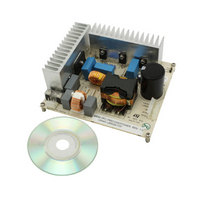EVL6563S-400W STMicroelectronics, EVL6563S-400W Datasheet - Page 24

EVL6563S-400W
Manufacturer Part Number
EVL6563S-400W
Description
EVAL BOARD FOR L6563(400W)
Manufacturer
STMicroelectronics
Type
Motor / Motion Controllers & Driversr
Specifications of EVL6563S-400W
Main Purpose
Power Management, Power Factor Correction
Embedded
No
Utilized Ic / Part
L6563
Primary Attributes
400W Power Factor Correction and Preregulator Combination
Secondary Attributes
Transition Mode & Active Tracking Boost Function.
Maximum Operating Temperature
+ 60 C
Product
Power Management Development Tools
Lead Free Status / RoHS Status
Lead free / RoHS Compliant
For Use With/related Products
L6563S
Other names
497-10488
Available stocks
Company
Part Number
Manufacturer
Quantity
Price
Test results and significant waveforms
2.8
24/38
Power management/housekeeping functions
A special feature of the L6563S is that it facilitates the implementation of the "housekeeping"
circuitry needed to coordinate the operation of the PFC stage with that of the cascaded DC-
DC converter. The functions realized by the housekeeping circuitry ensure that transient
conditions such as power-up or power-down sequencing or failures of either power stage
are properly handled. The L6563S provides some pins for this purpose.
As already mentioned, one communication line between the L6563S and the PWM
controller of the cascaded DC-DC converter is the PWM_LATCH pin (#8), which is normally
open when the PFC works properly. It goes high if the L6563S loses control of the output
voltage (because of a failure of the control loop) or if the boost inductor saturates, with the
aim of latching off the PWM controller of the cascaded DC-DC converter as well.
A second communication line can be established via the disable function included in the
RUN pin. Typically, this line is used to allow the PWM controller of the cascaded DC-DC
converter to shut down the L6563S in the case of a light load to minimize the no-load input
consumption of the power supply.
Figure 35. On/Off control by a cascaded converter controller via PFC_OK or RUN pin
The third communication line is the PWM_STOP pin (pin #9), which works in conjunction
with the RUN pin (pin #10). The purpose of the PWM_STOP pin is to inhibit the PWM
activity of both the PFC stage and the cascaded DC-DC converter. The pin is an open
collector, normally open, that goes low if the device is disabled by a voltage lower than 0.8 V
on the RUN pin (#10). It is important to point out that this function works correctly in systems
where the PFC stage is the master and the cascaded DC-DC converter is the slave or, in
other words, where the PFC stage starts first, powers both controllers and enables/disables
the operation of the DC-DC stage. This function is quite flexible and can be used in different
ways. In systems comprising an auxiliary converter and a main converter (for example, a
desktop PC's silver box or Hi-end flat-TV or monitor), where the auxiliary converter also
powers the controllers of the main converter, the RUN pin (#10) can be used to start and
stop the main converter. In the simplest case, to enable/disable the PWM controller, the
PWM_STOP (#9) pin can be connected to either the output of the error amplifier or, if the
chip is provided with it, to its soft-start pin.
The EVL6563S-400W offers the possibility to test these functions by connecting it to the
cascaded converter via the series resistors R28, R29, R30 and the connector J3. If the
PWM_STOP (#9) pin, which is an open-collector type, needs a pull-up resistor, connect it
close to the cascaded PWM for better noise immunity.
Doc ID 15796 Rev 2
AN2994
















